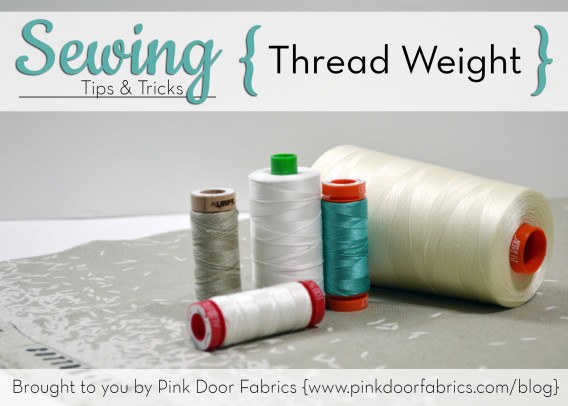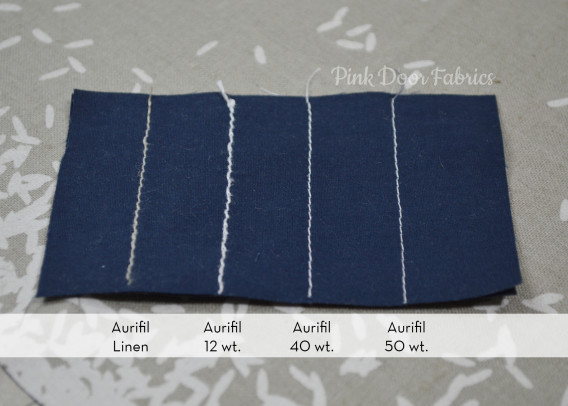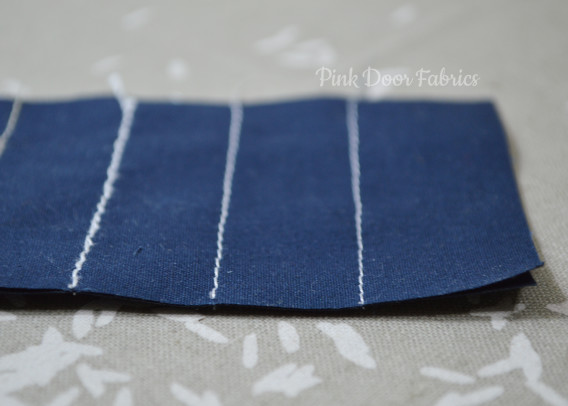
Hello! I hope you’ve all recovered from your New Year’s celebrations and are getting back into the swing of things like we are! It’s been a lovely couple days off, but you and I know it must come to an end. We’ve brainstormed and come up with a way to restructure and revamp our blog, posts and all.
We’ll start off the new year with a new weekly series, called Sewing Tips and Tricks! Every week, we’ll introduce you to a wealth of knowledge about sewing, as well as little sewing tips and tricks we like to utilize for ourselves. We feel that as a sewing community, you can’t ever have too much knowledge about sewing! I mean, everyone has a different perspective or way of doing things and we can’t improve if we don’t learn new things, am I right?

For this week’s sewing tip, I tested out four weights of Aurifil that I had on had for this post which included 50 wt., 40 wt., 12 wt., and linen thread. But first, let’s explain what each is for, because that’s realistically the best place to start. I generally only use Aurifil Cotton Mako thread but the weights and their uses can apply to any brand. I know other people are happy with Coats & Clark, and others yet are happy with Gutermann. It’s all a personal preference!
Weight
Weight measurement, designated as “wt”, uses a fixed weight system. The “weight” of the thread is actually a length measurement, determined by measuring the length of 1 gram of thread. The higher the weight number, the lighter the thread. For example, a thread labeled 60 wt. means that 60 meters of the thread weigh 1 gram. A 40 wt thread only takes 40 meters to weigh 1 gram, so it is heavier. This may seem confusing, but just remember: smaller weight number, heavier thread. This same measurement applies to paper, in case you were wondering.
— 50 wt. — Generally, I feel this is the best weight for piecing quilts or sewing seams. It’s thin and 100% cotton (though some people use polyester or a blend of both) and sits nicely in the seam when I press quilt blocks open. When I only have a 1/4″ seam allowance to work with, using a thick thread means the seam allowance is no longer 1/4″ once ironed. I need that seam accurate! I feel like I get flatter seams with the 50 wt. thread than I do with any other. Also, Coats & Clark 50 wt. is not the same as Aurifil 50 wt. It’s a bit thicker, though I’m not sure why. I prefer 100% cotton thread, because my machine likes it. I’ve also read several other blogs that state the cotton fabric you use in quilts, should last longer than the thread, in the event of future repairs. If you use polyester thread on seams, the fabric could disintegrate eventually leaving the poly thread, making the quilt much harder to repair than if the cotton thread just broke. I’ve not had a quilt long enough to test this theory so I can’t attest to the accuracy of it. Quilting with poly thread seems to be the standard for many longarmers. Again, I use 100% cotton Aurifil but I also quilt on a domestic machine, not a longarm (yet!).
— 40 wt. — This 40 wt. thread is the perfect thickness for machine quilting. I really love that it pops more on the quilt top and adds a little oomph! It’s not so thick that it’s really obvious when you stand back, but sometimes 50 wt. thread can really disappear and then all you’re hard work while quilting wasn’t worth it! Unless of course, you’re not wanting your quilting to be really visible, then it’s great! I will admit, I personally use 50 wt. MUCH more often than I use 40 wt., but I have used 40 wt. when I am free motion quilting a large blank space. It helps the quilting show up nicely!

— 12 wt. — Aurifil 12 wt. thread is amazing for hand quilting and embroidery. It shows up beautifully and of course comes in all sorts of amazing colors! For this thickness, Aurifil recommends Topstitch #90/14 needle, and you’ll need to loosen the upper tension a bit if machine quilting with this.
— Linen — I have to say, this thread matches Robert Kaufman Essex Linen in Flax PERFECTLY! It does NOT perform well for machine quilting or piecing as it’s not very strong and I had several thread breaks occurring. It would however be perfect for hand quilting little details (think Nana Company style!)
Well, that wraps up this week’s Sewing Tips and Tricks! Do you have any feedback to share? What are your experiences with thread weights? Does one brand work better for you than another?
 The infographic above goes over a brief description on needles. The right number in the needle size is 12 in the graphic, and can go as small as 6 or 8 (very fine needle for lace, chiffon, etc.) and up to 20 (very thick and strong needle for leather and denim). I don’t typically follow the number on the left of the needle size.
The infographic above goes over a brief description on needles. The right number in the needle size is 12 in the graphic, and can go as small as 6 or 8 (very fine needle for lace, chiffon, etc.) and up to 20 (very thick and strong needle for leather and denim). I don’t typically follow the number on the left of the needle size.















